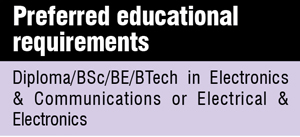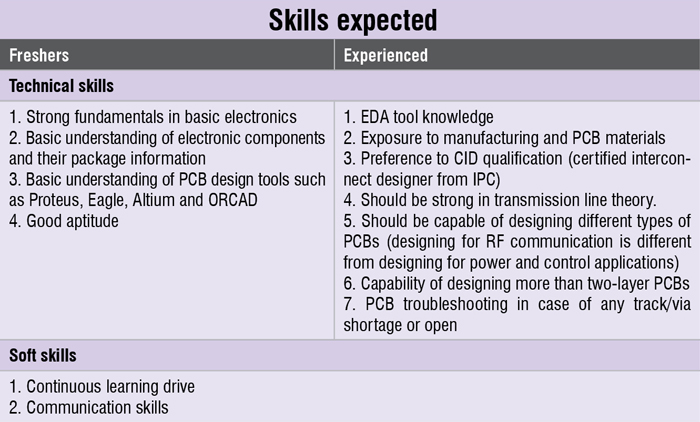A printed circuit board (PCB) designer uses software tools to design circuit boards, which are integrated into machines and devices that are as trivial as a toy to as serious as an aircraft. As a result, job requirements vary from industry to industry.

A PCB designer, typically, works either at a manufacturing facility or at an engineering firm in front of a computer, in an office or cubicle, designing the boards using specialised software tools. Each board must be created to accurate specifications, and he or she has to justify that it will function under diverse set of conditions.

Preference for VLSI and embedded
“IC design industry attracted the best talent from IITs and PCB design industry was the younger brother. But since last two decades, the issues that were to be addressed at the chip level have moved to the PCB area due to miniaturisation and ever-increasing frequency requirements,” informs O.J. Sathish, CEO, SIENNA ECAD Technologies Pvt Ltd. Hence career opportunities in the PCB designing industry have grown tremendously in the last ten years. The need for good PCB design engineers is felt across all major electronics companies.
It is a well-known fact that PCBs are the heart of electronic systems. Expanding horizons in electronics market has brought tremendous demand for trained and experienced PCB designers, informs Dhiraj Kumar, director, Systems Engineering, Argus Technologies. He says, “There are significant job opportunities in India for professionals with PCB design expertise.” However, the industry is currently running short of qualified designers in the area of electronic system design at all the levels. He adds, “Most freshers in electronics opt for VLSI design/verification and embedded software, creating a vacuum for core electronics designing jobs. On the flip side, this can be seen as an opportunity for freshers looking to get into PCB designing.”
Begin with testing and verification
In order to meet the growing demand for engineers, most electronic system design companies put freshers through an extensive training program of, typically, three months before allocating them to entry-level engineering programmes. Kumar informs, “Currently most engineering colleges have digital and analogue electronics labs as part of their curriculum, which is an advantage as compared to VLSI design area where a specialised training of one year is a must in order for them to be job-ready.”
companies put freshers through an extensive training program of, typically, three months before allocating them to entry-level engineering programmes. Kumar informs, “Currently most engineering colleges have digital and analogue electronics labs as part of their curriculum, which is an advantage as compared to VLSI design area where a specialised training of one year is a must in order for them to be job-ready.”
A fresher, typically, starts his career with footprint preparation and design verification. Later his work slowly moves into module designing, library creation and two-layered board design. Dhananjay Kulkarni, COO, Maven Systems says, “At an advanced level, the designer can build multilayer (six to eight) PCBs with mixed-signal, high-speed board design. And last stage is when he also starts analysing and contributing to thermal analysis, design for fabrication, assembly, testability and manufacturing–design for manufacturability (DFM), design for test (DFT), design for assembly (DFA) and design for fabrication (DFF).” In short, “There is value addition for the PCB designer right from the start of his career until he becomes a super-expert after 20 years.”
There is good scope in this industry for electronics hardware engineers, believes Amit Gohel, founder, Eleics Design. For freshers, he says, “Entry-level roles will be inclined towards PCB design verification, quality analysis and quality control initially. It will be a good learning curve for them to verify their seniors’ designs.” He adds, “Once they are design-ready, they would later be assigned to design small circuit boards and customer PCBs.”
Remuneration
Printed circuit boards are fundamental components of all electronics and the field is well entrenched in India, which is one of the top global manufacturers of PCBs today. Vivek Madhukar, COO, TimesJobs.com explains, “While starting salaries for freshers may be low, much like good programmers are in high demand, good PCB designers can also command salaries upward of 1.5 million (15 lakhs). Most careers for these skills are in the manufacturing, IT and engineering sectors.” Talking about locations for jobs, he says, “The golden triangle of Bengaluru, Hyderabad and Chennai account for a majority of jobs in the field, so freshers should be open to relocate.”
Kulkarni informs that a fresher’s pay package is typically 150,000 rupees per annum. At Argus Technologies, Kumar shares, “A fresh graduate would be offered a starting salary of 216,000 per annum whereas an experienced professional with two to three years of experience would get 360,000 per annum.” “We do hire fresh candidates from engineering colleagues and have no preference to IITs/NITs as such. Selection is based on a written test and personal interview. In the written test, our focus is mainly on basic electronics, mathematics and problem-solving skills.”







